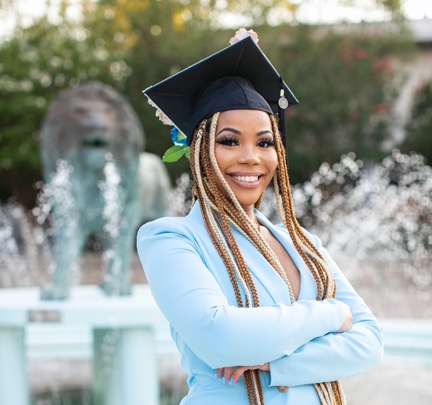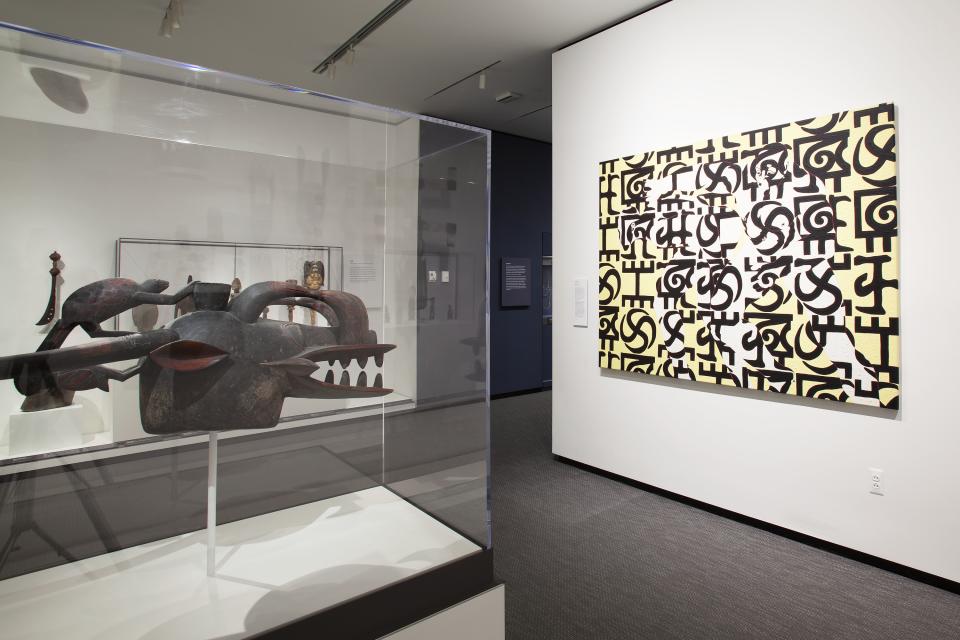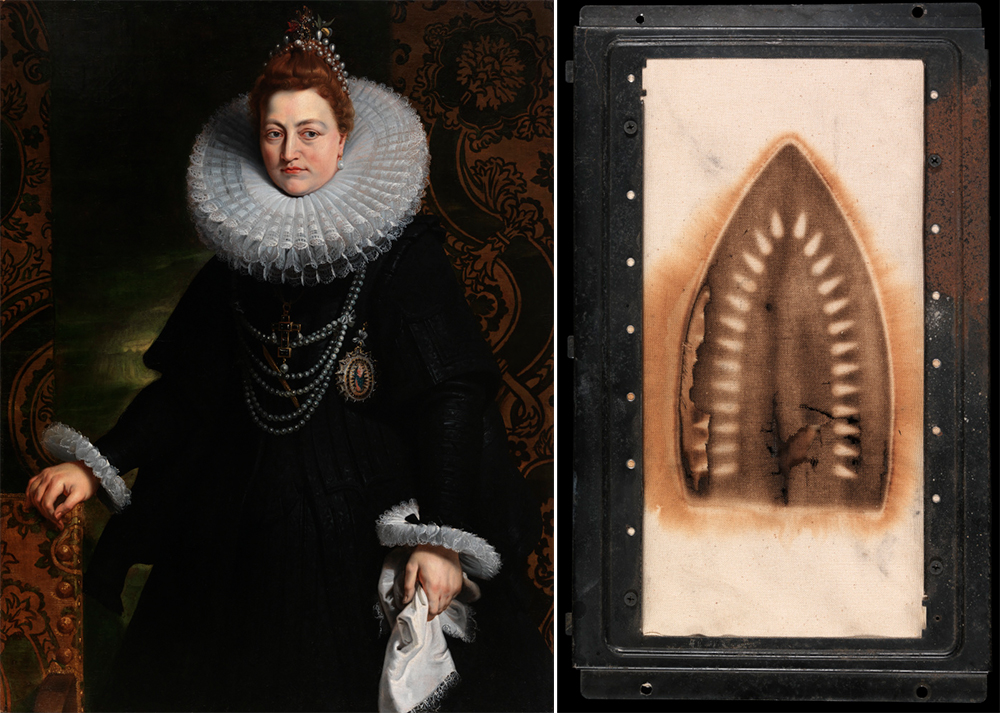- Open today, 10 am to 5 pm.
- Parking & Directions
- Free Admission
Double Takes: Unique Pairings and New Perspectives in the Chrysler Collection
–Avery Bolden, 2020 Association of Art Museum Directors Intern

Double Takes, 2021. Oval Gallery
This summer, Museum visitors who stop by the Oval Gallery will be greeted by a portrait of Walter P. Chrysler, Jr. that presents his apparent wealth and power. The famed art collector is dressed in his naval service khaki uniform and stands at North Wales, the sprawling estate he purchased in Warrenton, Virginia shortly after his father’s death. Mr. Chrysler’s portrait appears alongside Slick, Barkley L. Hendrick’s self-portrait. Hendricks made Slick in response to a New York Times review that largely praised the artist but also used racialized terms, saying Henricks was “a brilliantly endowed painter” who employed a “stylized slickness.” This pairing is one of the Chrysler Museum’s Double Takes, unlikely juxtapositions or mini-installations that raise provocative questions about themes like racial representation, standards of beauty, masculinity, implicit bias, white supremacy, and youth culture, among many others.

Avery Bolden, 2020 Association of Art Museum Directors Intern
As a summer 2020 Association of Art Museum Directors summer intern, I spent twelve weeks at the Chrysler Museum and was tasked with bringing the Double Takes initiative to life to commemorate the 50th anniversary of Walter P. Chrysler, Jr.’s transformative gift of art to the City of Norfolk. Under the direction of Seth Feman, PhD, the deputy director for art & interpretation and curator of photography, I used the Chrysler’s permanent collection to promote critical thought and conversation about art and its connection to the world.
Museum curators, educators, and I sought to highlight the diverse growth in Walter P. Chrysler, Jr.’s art collection by installing these Double Takes throughout the Museum. With the harsh realities of the COVID-19 pandemic and social unrest following the death of George Floyd last summer, there was an added need to incorporate activations that provoke conversation about racial disparities across the globe and the importance of community and cooperation.

A selection of works from the late 19th century to the late 20th century, including Senufo helmet mask and Owusu-Ankomah’s Movement No. 1 on view in the Arts of Africa Gallery at the Chrysler Museum of Art
To start developing ideas for the project, I brainstormed topics that I felt would promote conversation and critical thinking. I then went on a tour of the Museum with Seth, where we discussed the themes of each gallery and possibilities for Double Takes that were already on view. We visited the storage rooms and studios, where I looked at works of art that were not on view but may be meaningful additions to my growing list of ideas. I also connected virtually with members of the curatorial and education departments. We discussed specific works of art and topics that they thought highlighted the essence of the Double Takes project. I felt it was important to have input from many departments throughout the Museum. While each curator gave knowledgeable insight into specific works of art and their history, members of the education team created ideas based on their understanding of the Chrysler’s audience and their daily interaction with visitors. It was interesting to see how everyone’s contributions varied because of their different experiences with the collection.
With inspiration and advice from colleagues and additional research, I solidified specific themes and grouped pairings of art within these themes. I had additional conversations with Seth, as well as the curatorial and education departments, to discuss and revise the Double Take proposals. I was intrigued to see how much thought and work went into moving projects forward. I learned that I had to consider the availability of each piece, the ability and inability for specific works to be moved based on size and location, and how each location would affect the condition of the work itself. I also drafted labels for each comparison and learned the extensive process for having labels edited and approved. While I knew the project would continue to develop after my internship ended, I was able to draft and move forward with approximately twenty proposals during my twelve-week internship.

(Left) Attributed to Peter Paul Rubens (Flemish, 1577-1640), Portrait of Archduchess Clara Eugenia, 1616, Oil on canvas, Gift of Walter P. Chrysler, Jr., 71.462 (Right) Willie Cole (American, b. 1955), Untitled, 1991, Scorch on canvas in metal frame, Gift of the American Academy of Arts and Letters, New York; Hassam, Speicher, Betts and Symons Funds, 2011, 2011.5.1
Among them was a pairing Peter Paul Rubens’ Portrait of Archduchess Clara Eugenia with Willie Cole’s Untitled. The historical portrait’s comparison to Cole’s contemporary work is meant to connect their similar emphasis of fabric to history and memory. Untitled’s scorched imprint of an iron on canvas resembles the historical diagrams of slave ships and references the domestic work of African women in the 1930s and 1940s. Ruben’s portrait of the Archduchess utilized images of fine fabric and ornamentation to relay her wealth and power, as her reign over the Netherlands and association with the King of Spain made her one of the most powerful women in the European sixteenth and seventeenth centuries. Ruben’s portrait in conjunction with Cole’s work, however, reminds us that, through her credentials, Eugenia contributed to the distribution of African people during the Atlantic Slave Trade.
As a recent graduate of Old Dominion University (ODU), I was eager to put my bachelor’s degree in art history to work. Since I can remember, I have always taken a special interest in art and museums. My mother never failed to remind me that my first experience as an art spectator was when I was four months old. Though art surrounded me throughout my childhood and early adulthood, it was not until my sophomore year at ODU that I decided to let go of my “practical” career path in industrial-organizational psychology and focus on building a career in art curation, specifically surrounding African and African diasporic art. Truthfully, it was the required-turned-recreational visits to the Chrysler Museum that played an integral role in my decision to change course to art history. I had become mesmerizingly aware that art went far beyond an artist’s formal skill or their ability to paint and sculpt realistically. In addition to those things, art facilitates the telling of history and culture. Art has the ability to evoke emotion, connect cultures, and challenge ideals. I wanted to expose the public to this way of thinking.
Beginning a fellowship such as this, with a need for interaction between colleagues and time spent in the Museum itself, initially seemed difficult last summer during a pandemic. The experience, both in-person and virtually, however, taught me the importance of being able to adapt to unprecedented circumstances and having an adaptive and cooperative working environment. I learned so much during my time as an intern. While I would have hoped for more time in the Museum galleries, storage rooms, and studios, I do not believe the limited in-person interaction last year hindered me from gaining the knowledge I need to be successful in my future endeavors. I would like to thank the Association of Art Museum Directors and the Chrysler Museum of Art for giving me the opportunity to participate in the fellowship. I am excited to utilize the knowledge I have gained to further build my career in curation and am equally as excited to see the Double Takes project come to life!

